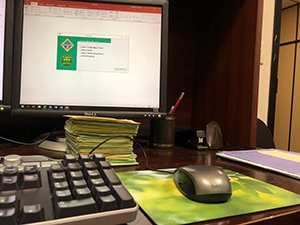"Absolutely beautiful!"
"Another great hike."
"Wet trail but saw a Florida panther."
I read a lot of these. You see, part of my work is to process Trailwalker comment cards for the Florida Forest Service Recreation Unit, so I come across the condensed adventures of intrepid trail walkers every day. And each time, my curiosity is piqued more than before. I have so many questions, like “What’s all the hiking hullabaloo?” or “What is really out there?” or “Why am I using the word ‘hullabaloo’?” I finally decided to find the answers to these questions on a hike for myself.

In full disclosure, I am not the adventurer type. I have never hiked through the forest, though in fairness to the forest, you could say I have never hiked. Without knowing what to fully expect, I opted to start off relatively close to home. I chose the Ravine Loop trail on Bear Creek Educational Forest at Lake Talquin State Forest near Tallahassee. I guessed that the 1.8-mile trail wouldn’t be too ambitious for an inexperienced hiker. Was it too ambitious? Read on!

I decided to depart on a mild April Saturday morning. Before the Ravine Loop trail proper, the hiker is introduced to the area by The Living Forest Trail, a brief, interpretive [interactive] trail featuring signposts with push-button activated audio recordings that describe some of its native trees’ history and habitat. These were informative and give some personality to the dense flora that we often take for granted. Ravine boasts over 50 identified tree and shrub species that are posted along 23 interpretive stations, marked A – V. Brochures called Interpretive Arborvitae are available at the trailhead’s kiosk that coincide with the stations along the trail. The morning temperature was pleasant under the tree canopy’s shade, and the forest was still showing off its spring vegetation of Dogwood shoots and blooming Mountain Laurel. Most of the way, the trail loops around a stream that supports deer, beaver and other critters that refused to flock to me like that scene out of Bambi that I kept imagining on the drive there. I noticed blue squares painted on certain trees—I later learned that these are called blazes and are meant to lead the way through the forest at intervals of visibility. At each bend, the next blaze is visible in the distance to guide you. This was a welcome development to someone like me with the survival skills of an infant. The letter markers also gave me an indication of the distance traveled and distance remaining.

…Which was also a welcome development, because by about “E,” I worried that I had made a huge mistake. I had not anticipated the trail’s inclines, which, for a native South Floridian, approximately resemble Mount Everest (give or take). I steadied my pace and forged on, determined to not be defeated by the trail. The midday temperature increased rapidly, and with tongue flagging like a Saint Bernard, I pressed forward. But I realize now that a slower pace allowed me to focus more on the details: the babbling of the trailside stream; a set of wandering deer tracks; a cardinal flitting from tree to tree. This was the way the trail was meant to be experienced.
At around “S,” I felt encouraged, even emboldened, and found a second wind. I completed my journey feeling a sense of pride and appreciation; it turns out that the Ravine Loop was just ambitious enough.
As experience is the best teacher, here are some recommendations for my fellow hiking newbies:
- Start out early enough to beat the noon heat—you will be shocked to discover that it is more difficult to appreciate the scenery when you are roasting in your own juices.
- Wear comfortable walking shoes. This may sound obvious, but make sure your shoes have a substantial toe cap and a broad heel for hiking steep inclines.
- The trail can be steep, and after a spring rain, unpredictable. For optimal traction, when walking uphill, plant your heel first, then shift your weight to the rest of your foot as you motion forward. When walking downhill, it’s similar, except you want to plant your toes first followed by the rest of your foot.
- Wear comfortable, long pants appropriate for the weather. Just trust me on this one: you will want to shield your legs from low branches, snapping twigs, and jumping or biting “things.” Remember that this is the forest; there will be insects and critters. Wear a hat. It will deflect flying, crash-course insects and spider webs.
- It only seems like buzzing creatures are out to get you. Don’t take it personally.
- Take water and a protein bar. Hydration is essential on long or strenuous hikes.
- Research your trail for the level of strenuousness beforehand. This is something that I did not know to do. I will next time.
- Pace yourself. You’ll be glad you did.
The Florida Forest Service website posts trail maps, Interpretive Arborvitae, and information on the Trailwalker Program. Join me out there hiking our beautiful and thriving Florida Forests and I hope to read your story on a comment card! For more information about our forests.


